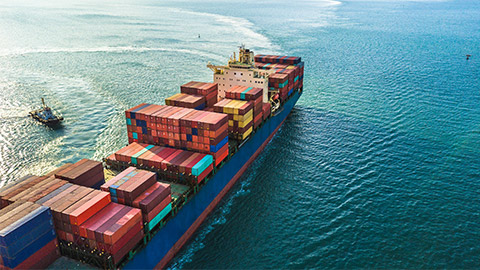Have you ever thought about how connected our world is? We can walk into a shop in any country of the world and buy foods from the other side of the globe. We can wear the same clothes and buy the same furniture regardless of where we live. Businesses that operate globally have enabled this. The development of technology such as the internet has changed the way we live and work, connecting with people and organisations anywhere, in an instant. This impacts any business, regardless of how big or small the business is or whether they operate in one or many countries. Some part of their operations is likely to be impacted by globalisation. In this first topic, we will explore the concept of globalisation and start to think about how this impacts business today.
Welcome to Topic 1: Impact of Globalisation on the Business Environment. In this topic, you will learn about:
- The importance of international business and globalisation.
- Different ways in which organisations can operate globally.
- A range of key terms and their meanings which we will refer to throughout the subject.
- What some of the main views on globalisation are.
- The impacts of globalisation.
These relate to the Subject Learning Outcomes:
- Explain the impact of globalisation on the business environment.
- Describe the fundamental frameworks and strategies for competing successfully in a global economy.
Welcome to your pre-seminar learning tasks for this week. Please ensure you complete these prior to attending your scheduled seminar with your lecturer.
Click on each of the following headings to read more about what is required for each of your pre-seminar learning tasks.

Hello there, we would love to know a bit more about you! International business is something we cannot remove ourselves from in this globalised world.
Introduce yourself in 'Topic 1: Forum Activity 1'.
You can access the activities by clicking on the links in the topic. You can also navigate to the forum by clicking on 'BUS100 Subject Forum' in the navigation bar for this subject.
Let us get a feel for the globalised world we live in and the different ideas presented by authors on the topic of what global business means. Read the two (2) following sections:
- Section 1.1 ‘How global are we?’ in de Kluyver, CA 2012, Fundamentals of global strategy, Saylor Foundation.
- Section 1.4 ‘The globalization debate’ in Carpenter, MA & Dunung, SP 2011, International business, Saylor Foundation.
Reflect on the different ideas presented in these readings regarding a uniform, single market approach versus a semi-global approach where the local/regionalised market plays a role. Can you think of any examples of businesses that operate in a way that supports these different views?
Share your thoughts in a short post in your reflective journal.
You can access the reflective journal by clicking on ‘Journal’ in the navigation bar for this subject.
Read section 1.4 ‘What is a global corporation?’ in de Kluyver, CA 2012, Fundamentals of global strategy, Saylor Foundation.
Find an example of an organisation that fits at least one (1) of the four dimensions that define corporate globality (Gupta, Govindarajan & Wang, 2008). Then, share your example in your reflective journal, explaining briefly which dimensions it aligns with and why.
The fourth dimension that defines corporate globality is the global mindset (Gupta, Govindarajan & Wang 2008).
Read Kelly, N 2019 ‘5 ways to foster a global mindset in your company’, Harvard Business Review to learn more.
Read Vanham, P 2019, ‘A brief history of globalization’, World Economic Forum.
Read through this week’s topic content.
The importance of international business and globalisation

In today’s world, we cannot imagine a business without having some aspect of it being international. Almost all products or services have international components when it comes to either their supply chain or their customer base (Collinson et al. 2020). In other words, an organisation is increasingly likely to operate across national borders in two or more countries. So, just how significant is this global aspect in business today?
About a quarter of all global production is exported today, this is over 40 times more than in 1913.(Our World in Data, 2018)
This shift has led to national economies integrating into a global system – which is what we refer to when we talk about globalisation. Globalisation has led to enormous growth in trade where businesses are selling and buying more, across the entire world (for both goods as well as services). Globalisation refers to the interconnection of economies, political systems, and social and cultural aspects of our world today.
When it comes to measuring the important international trades, the gross domestic product (GDP) is the go-to economic measure we use (see following image). It is important to note that trade is not a new concept, in fact, humans have been bartering forever. There has been lots of international trade when we look back at history. In many ways we could argue that trade has driven economic growth as well as globalisation. Understanding the history of trade allows us to understand the key drivers behind the globalised world we live in currently.
International trade in services accounted for 7 % of world GDP in 2019.(UNCTAD, 2020)
Different ways in which organisations can operate globally

Now that we have looked at how expansive international trade is and started to grasp how important globalisation is for business today, let us think about what a global corporation is. We could of course say that an organisation should have parts of its operation across all of the major world markets for it to be considered a global corporation. Alternatively, we could use the reach of the organisation’s supply chain or the diversity of its leadership or various other measures to determine globality.
Instead, we will use the model put forward by Gupta, Govindarajan and Wang (2008), which suggests defining an organisation’s corporate globality based on four (4) dimensions:
- The globalisation of market presence – how global is the organisation’s market presence and customer base?
- The globalisation of the supply base - how many different countries the organisation sources from or has dispersed parts of its supply chain to various locations? In other words, where does an organisation base its manufacturing or service provision facilities?
- The globalisation of the capital base – how much of the financial structure of the organisation is globalised? This includes things like the exchanges a company is listed on, where it attracts capital and how it finances its operations.
- The globalisation of the corporate mindset – how able is an organisation at dealing with diverse cultures?
When we study different organisations, we can use this model to assess their corporate globality based on these four dimensions.
Key terms and their meanings
We will have a look at some key concepts that will help us define our discussions around global business, this is terminology we will come back to throughout this subject so ensure you familiarise yourself with these terms.
| International business | refers to a firm or organisation whose economic activities take place across two (2) or more countries. This includes business with any part of the production or distribution of goods or services taking place across national borders. |
| Multinational | refers to a firm or organisation which adjusts its products and processes across several countries that it operates in. |
| Global corporation | refers to a firm or organisation that operates across different countries, offering the same products and services everywhere. |
| Semi-globalisation | refers to the concept that whilst organisations operate in a globalised world, a considerable proportion of the way business operates is localised or tailored to a domestic market. |
| Economies of scale | this refers to the efficiencies related to increasing or decreasing the amount of production. |
| Trade | this refers to transactions between different parties located in different places (this may be different parts of the same country, or it may be different parts of the world, in which case we would refer to this as international trade). |
Knowledge check
Main views on globalisation
Different authors have different ideas about globalisation. Levitt (1983) for example, posed that a business should have the same approach everywhere. In other words, sell the same thing in the same way regardless of the market they operate in. Friedman (2005) had similar ideas, even though he looked more at the production rather than the market and its customer base. He based his ideas around a ‘flat earth’ due to certain key events, for example the internet and other key technological and historical events. This, in his view, enabled the same approach when it comes to work, collaboration knowledge sharing regardless of the location or time zone and because of this he felt globalisation enabled a uniform approach. In Friedman’s view this flattened the differences between regions.
Ghemawat (2007) took a different stance and said, based on differences between countries or regions being more significant than were given credit for, the localised approach the business takes as part of their operations is valuable and should be seen as an opportunity. Moore and Rugman (2005) also reject a uniform single market concept and offer a more regional perspective. Both these views align with what we call semi-globalisation.
Distance
As part of the globalisation debate, we need to tackle the concept of distance. When Friedman proposed a ‘flattening of the earth’ it suggests that distance between different countries or regions does not matter. When it comes to business, however, this assumption can be harmful.
In terms of distance, we are really talking about differences in the way one country operates from another. We can analyse this distance based on Ghemawat’s cultural administrative geographical and economic factors (CAGE 2007). Each of these factors influences global business.
When it comes to cultural distance, we could consider things such as religion, cultural beliefs, social norms and expectations, and language. All of these can become barriers and create distance when we are operating business globally. Cultural differences have an influence on our preferences and ultimately our wants as consumers.
When it comes to administrative distance it is the policies and legal frameworks (the laws of the different countries we operate in); the relationships, treaties and international agreements between countries that determine distance. Different countries have different rules and regulations. Think, for example, of different tariffs restrictions on foreign investment or foreign company ownership trade quotas and any measures or subsidies that encourage domestic production, which influence the global business environment.
In terms of geographic distance, we need to consider more than the mere physical distance from one country to another. We also need to consider how big the countries are in which we operate, how easily accessible different areas within each country are, what kind of transportation, topography and infrastructure we have available to operate with.
The impacts of globalisation
The following figure provides a good starting point for us to explore the impacts of globalisation. In addition to the impacts at the level of the geographical location and the level of the firm, the overarching impacts of globalisation have resulted in increasing interdependence of people across the globe.
Increasing interdependence of locations
- Cross-border migration
- Blending of cultures
- More homogeneous consumption patterns
- Global value chains connect local clusters
- Standardisation of various kinds
- Cooperation in supernational institutions.
Increasing interdependence of firms
- More joint ventures, alliances and M&A
- Growing cross-border competition for markets, resources and expertise
- Shared agenda set by governance institutions.
Interdependence is a key concept when we look at the impacts of globalisation. It refers to a mutual reliance where there is a high degree of independence. Impacts on one key player can significantly affect the other actors who rely on this player (Collinson et al. 2020). In a globalised world, when one firm or one country is impacted, interdependence means there is a flow-on effect. For example, with economies being as intertwined as they are, the effects of one struggling nation can be felt across global markets.
Globalisation and the growth of the multinational corporation have blurred the boundaries between countries. This has affected the identity and culture of individual countries as well as consumption patterns, which have become more uniform across different regions. Whilst countries remain independent (and we cannot ignore the differences between them in terms of distance), they are also highly dependent on what is happening in the countries around them as well as further abroad. Lower tax rates in other countries can sway the multinational corporation to relocate parts of its operation elsewhere. Similarly, legal and policy changes need to be carefully considered and compared to what is happening in other countries. This increase in power for the multinational corporation has reduced the power of individual nations. In this way locations are increasingly dependent on one another. At the business level, mergers, acquisitions, outsourcing and joint ventures have increased the interdependence of firms. Technology has enabled collaboration with the sharing of ideas happening instantly across the globe.
There are many benefits to globalisation. Bringing together people from all over the world, for example, sharing of cuisines, improved standards for manufacturing, and increase in democracies and improvements to the role of women and access to education. However, it has also highlighted inequalities between countries, caused environmental degradation and created a bigger gap between the world’s rich and poor. This video discusses the positive and negative impacts of globalisation.
Reflection
Reflect on some of the positive and negative impacts globalisation has on your home country.
Key takeouts
Congratulations, we made it to the end of the first topic! Some key takeouts from Topic 1:
-
There are different views regarding our global markets being ‘flat’ as opposed to globalisation affecting business in a more semi-global manner where differences between markets and a regionalised approach play an important role for business today.
-
Global companies can be described as having a global market presence, supply-chain, capital base, as well as a corporate mindset.
-
Distance between countries can be considered in terms of four (4) dimensions, each of which impacts business in differing ways:
-
Cultural
-
Administrative
-
Geographic
-
Economic
-
-
There are many positive as well as negative impacts of globalisation.
-
Globalisation has led to interdependence, both at the level of the country as well as at the level of the organisation. This has also led to our lives being impacted as a result of living in a globalised world.
Welcome to your seminar for this topic. Your lecturer will start a video stream during your scheduled class time, you can access your scheduled class by clicking on ‘Live Sessions’ found within your navigation bar and locating the relevant day/class or by clicking on the following link and then click 'Join' to enter the class.
Click here to access your seminar.
The learning tasks are listed below, these will be completed during the seminar with your lecturer. Should you be unable to attend, you will be able to watch the recording which can be found via the following link or by navigating to the class through ‘Live Sessions’ via your navigation bar.
Click here to access the recording. (Please note: this will be available shortly after the live session has ended.)

In-seminar learning tasks
The in-seminar learning tasks identified below will be completed during the scheduled seminar. Your lecturer will guide you through these tasks. Click on each of the following headings to read more about the requirements for each of your in-seminar learning tasks.
Read about the Walmart mini case and consider the ideas of a ‘flat’ world as described by Levitt (1983) and Friedman (2005), versus a semi-global one as described by Ghemawat (2007) and Moore and Rugman (2005). Discuss this in the breakout room group you have been allocated to. After your group discussion, you will be asked to summarise your main points, so be ready to share them with the class. Wherever possible, try to justify your points, for example “I feel that the Walmart mini case supports the ideas of a flat world because....”
Seminar discussion based on the examples you have found of organisations that fit at least one (1) of the four dimensions that define corporate globality (Gupta, Govindarajan & Wang 2008). Be prepared to share your examples(s) and ask questions.
Welcome to your post-seminar learning tasks for this week. Please ensure you complete these after attending your scheduled seminar with your lecturer. Your lecturer will advise you if any of these are to be completed during your consultation session. Click on each of the following headings to read more about the requirements for each of your post-seminar learning tasks.
Reflect on what you learnt about the impacts of globalisation during this first topic. Explain two (2) insights you were surprised about in relation to globalisation and explain why they surprised you. Post your reflection in your reflective journal.
Assessment 1 – Review the requirements for Assessment 1 and develop questions you have for your lecturer. Begin the initial research for this assessment based on your topic allocation, focusing on collecting and reading relevant resources.
Each week you will have a consultation session which will be facilitated by your lecturer. You can join in and work with your peers on activities relating to this subject. These session times and activities will be communicated to you by your lecturer each week. Your lecturer will start a video stream during your scheduled class time, you can access your scheduled class by clicking on ‘Live Sessions’ found within your navigation bar and locating the relevant day/class or by clicking on the following link and then click 'Join' to enter the class.
Click here to access your seminar.
Should you be unable to attend, you will be able to watch the recording which can be found via the following link or by navigating to the class through ‘Live Sessions’ via your navigation bar.
Click here to access the recording. (Please note: this will be available shortly after the live session has ended.)

- The website “Our World in Data” is a valuable data depository on international business.
- The Forbes Global 2000 list tracks the largest global companies in terms of their assets, market value, sales and profits.
References
- Carpenter, MA & Dunung, SP 2011, International business, Saylor Foundation, https://saylordotorg.github.io/text_international-business/s05-04-the-globalization-debate.html
- Collinson, S, Narula, R, Rugman, AM & Qamar, A 2020, International business, 8th edn., Pearson Publishing.
- Gupta, AK, Govindarajan, V & Wang, H 2008, The quest for global dominance, 2nd edn., Jossey-Bass.
- Friedman, TL 2005, The world is flat: A brief history of the twenty-first century, Farrar, Strauss and Giroux.
- Kelly, N 2019, ‘5 ways to foster a global mindset in your company’, Harvard Business Review, https://hbr.org/2019/07/5-ways-to-foster-a-global-mindset-in-your-company
- Kluyver, CA 2012, Fundamentals of global strategy, Saylor Foundation, https://saylordotorg.github.io/text_fundamentals-of-global-strategy/s03-01-how-global-are-we.html
- Levitt, T 1983, 'The globalization of markets', Harvard Business Review.
- Moore, K & Rugman, A 2005, ‘Globalization is about regionalization,’ McGill International Review, 6(1):37–45.
- Moore, K & Rugman, A 2005, Summer, The myth of global business, European Business Forum, http://www.europeanbusinessforum.com
- Peng, W & Meyer, K 2019, International business, 3rd edn., Cengage Publishing EMEA.
- UNCTAD 2020, Handbook of Statistics 2020, United Nations Publications.
- Vanham, P 2019, A brief history of globalisation, World Economic Forum, https://www.weforum.org/agenda/2019/01/how-globalization-4-0-fits-into-the-history-of-globalization/

